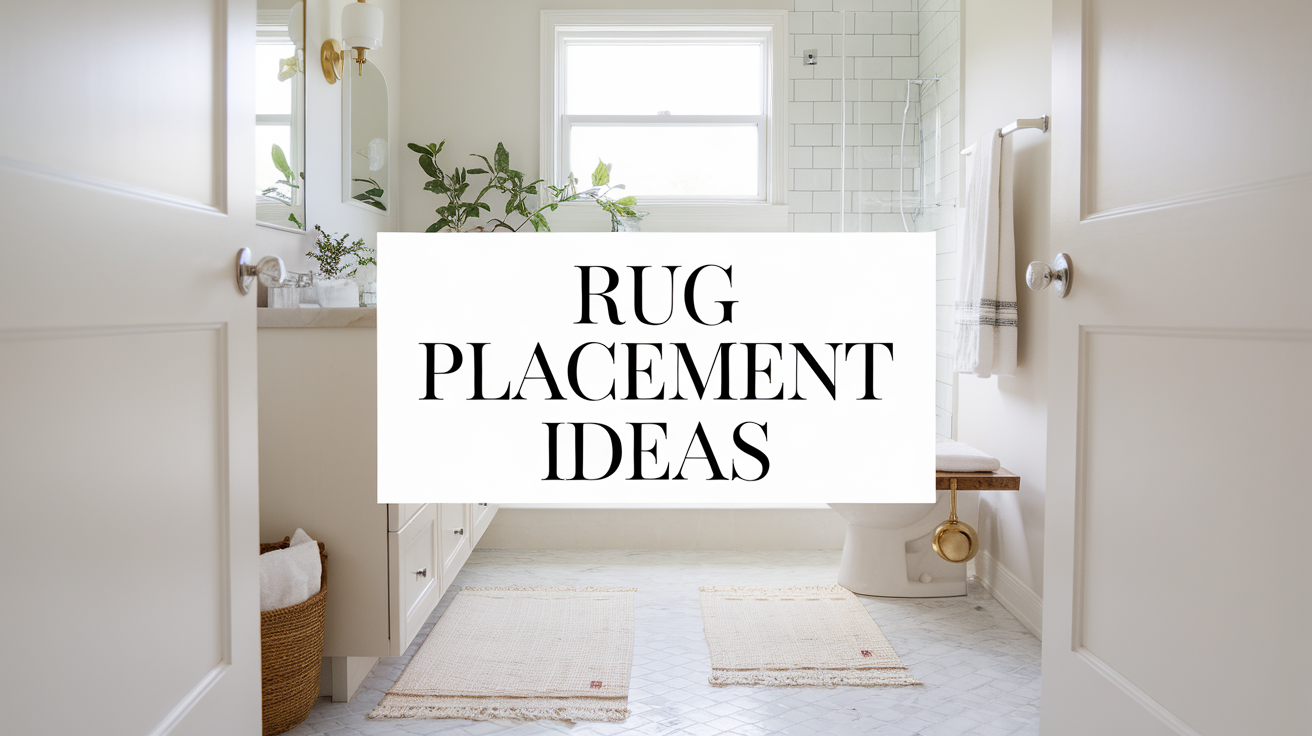Rugs may seem like a small detail, but in a bathroom with limited space, they can make a big difference. The right rug placement doesn’t just look better—it also adds comfort and helps keep the floor dry and safe.
In small bathrooms, every inch counts. A poorly placed rug can make the room feel cramped or cluttered, while a well-placed one can improve how the space works and feels. Good placement can also guide movement, define areas, and bring a neat finish to the layout.
This blog shares 25 smart ways to place rugs in small bathrooms. From practical ideas to simple style tips, you’ll find suggestions that work for different layouts and needs.
These ideas are meant to help you make the most of your space, one small update at a time.
Top Rug Placement Ideas for Small Bathrooms
In small bathrooms, rug placement plays a key role in comfort, safety, and overall flow. The right spots can help prevent slips, define zones, and make the room feel more complete without taking up valuable space.
These four ideas focus on high-use areas where rugs can be both practical and easy to manage.
1. In Front of the Sink or Vanity
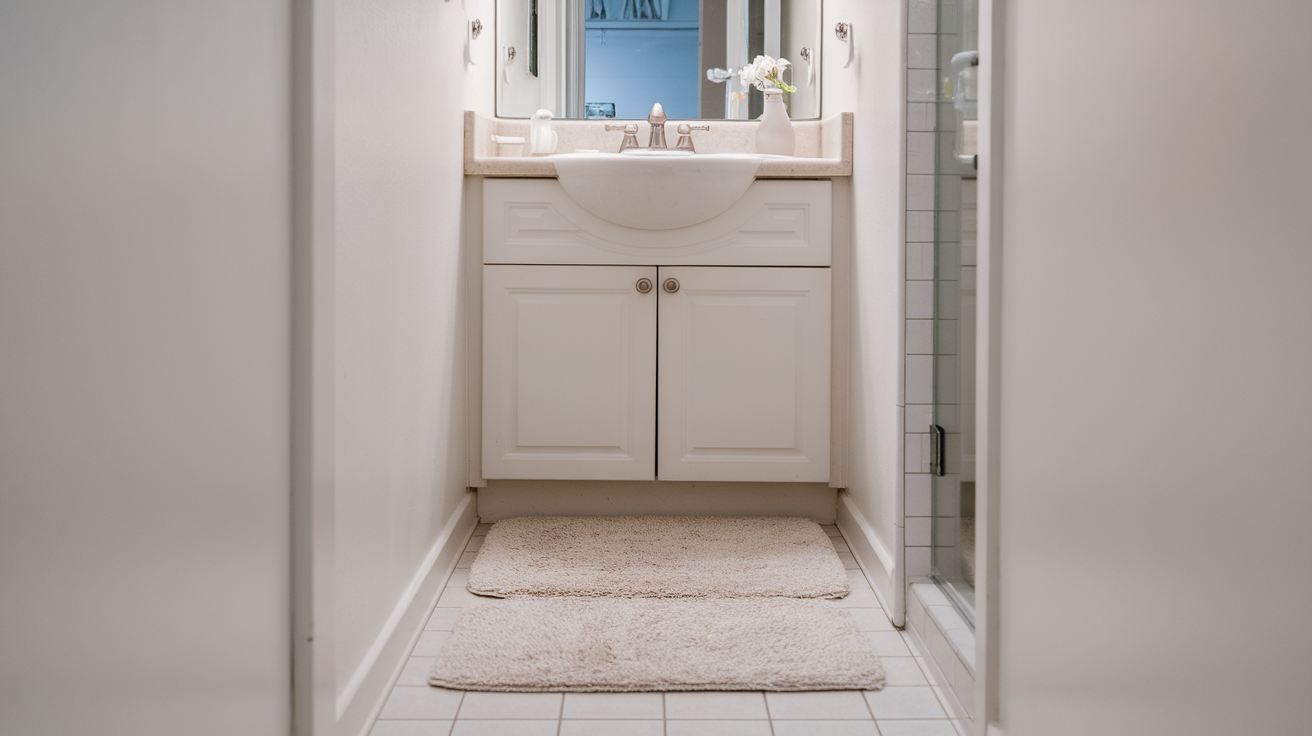
A rug in front of the sink makes daily routines more comfortable. It catches drips from handwashing and offers a soft spot to stand during teeth brushing or face washing. This small addition also helps protect the floor from water damage.
Choose a rug that’s the right width for the space. Make sure it doesn’t block cabinet doors or roll up at the edges. A low-pile, quick-drying rug is best to keep things simple and easy to clean.
2. Beside the Bathtub or Shower
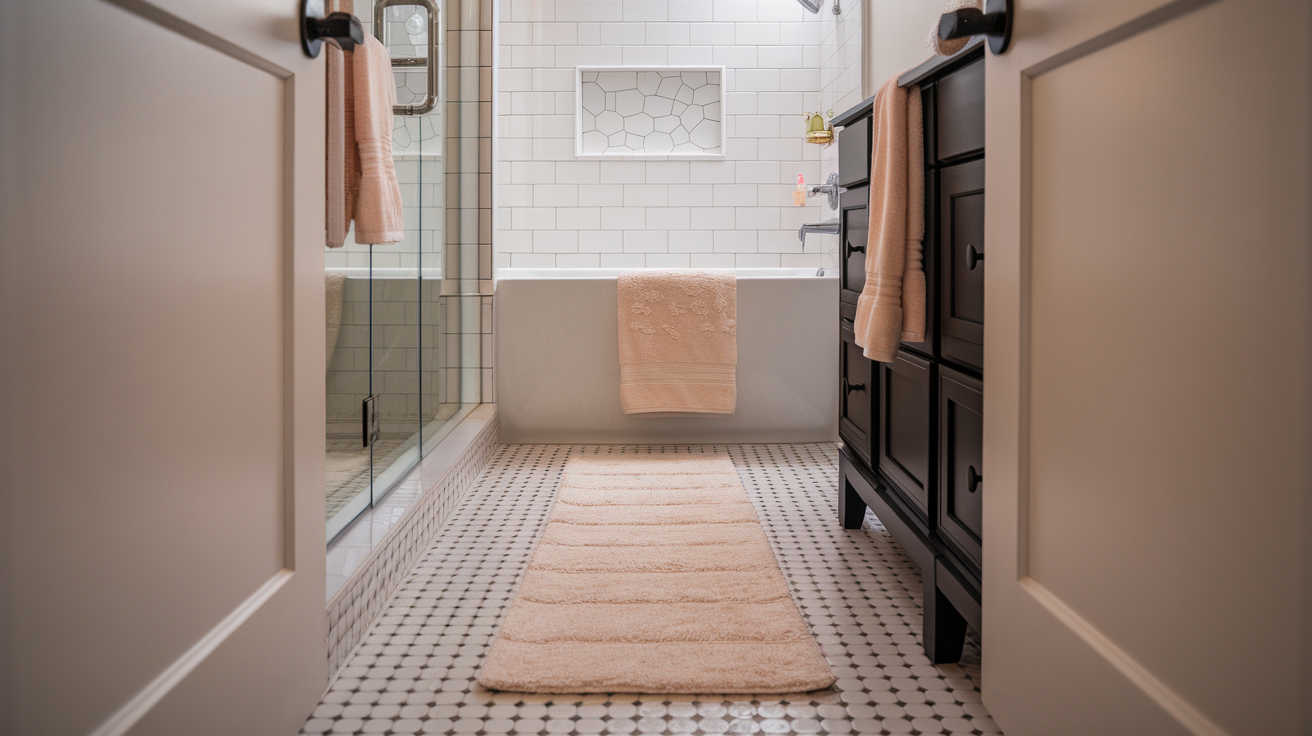
A narrow runner or soft bath mat placed along the edge of the tub or shower helps soak up water and reduces the chance of slipping. This is especially useful after a shower when the floor tends to get wet.
Pick a rug with a non-slip bottom and quick-drying fabric. Look for microfiber or cotton blends that are soft underfoot but easy to wash and dry.
3. Center of the Bathroom

If your bathroom is square or has open space in the middle, placing a rug in the center can add warmth and help pull the room together. It adds softness to tile or wood flooring and gives the space a finished look.
Pick a small, flat-weave rug with a color or pattern that matches your towels or shower curtain. Just be sure there’s enough room to walk around it comfortably.
4. In Front of the Toilet

A U-shaped rug that fits around the base of the toilet makes this area more comfortable and helps keep the floor clean. It can catch splashes and provide warmth when standing.
Look for a rug that’s labeled as washable and water-resistant. These rugs are easy to clean, hold their shape, and dry quickly, which is helpful in high-moisture areas.
5. Entryway of the Bathroom
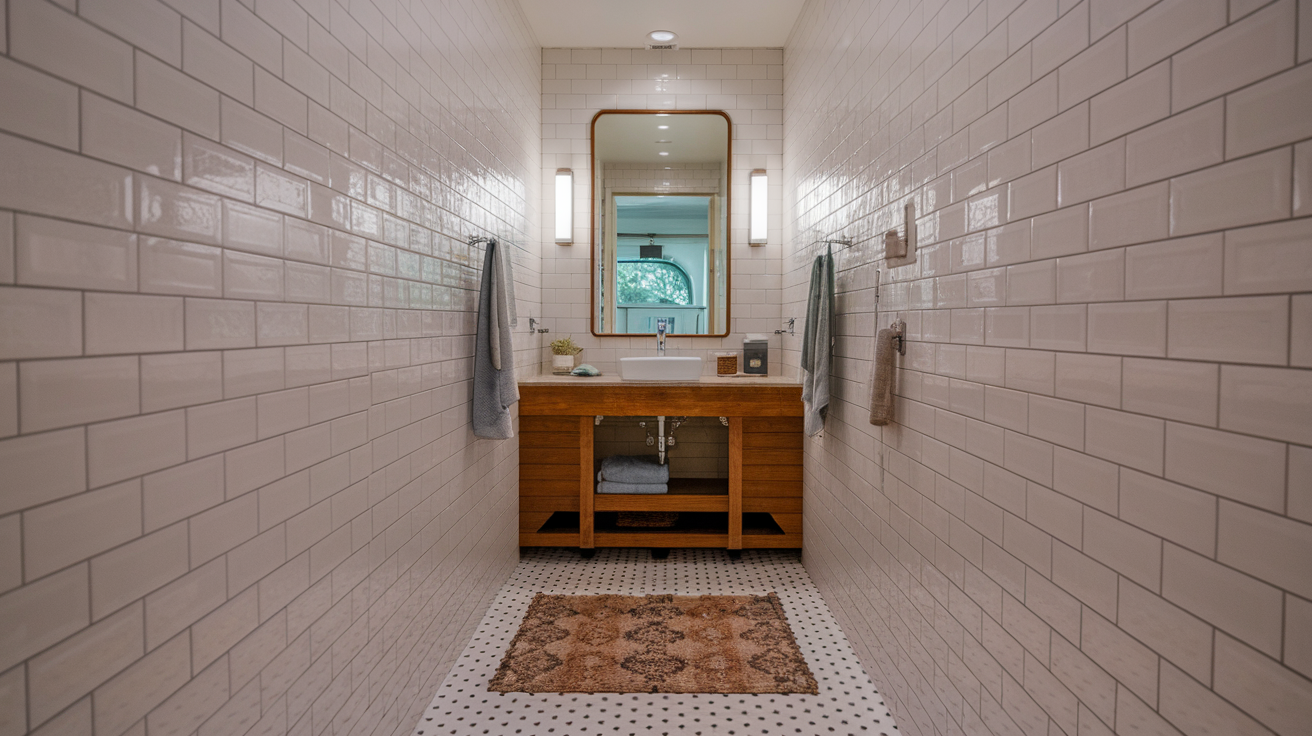
Placing a rug just inside the bathroom door helps define the entry and keeps outside dirt from spreading across the floor. It also softens the first step into the room, especially if the rest of the floor is tile or stone.
Choose a small rug that fits neatly within the doorway area. A non-slip backing is key here, as wet feet can make smooth floors more slippery right by the entrance.
6. Under a Floating Vanity
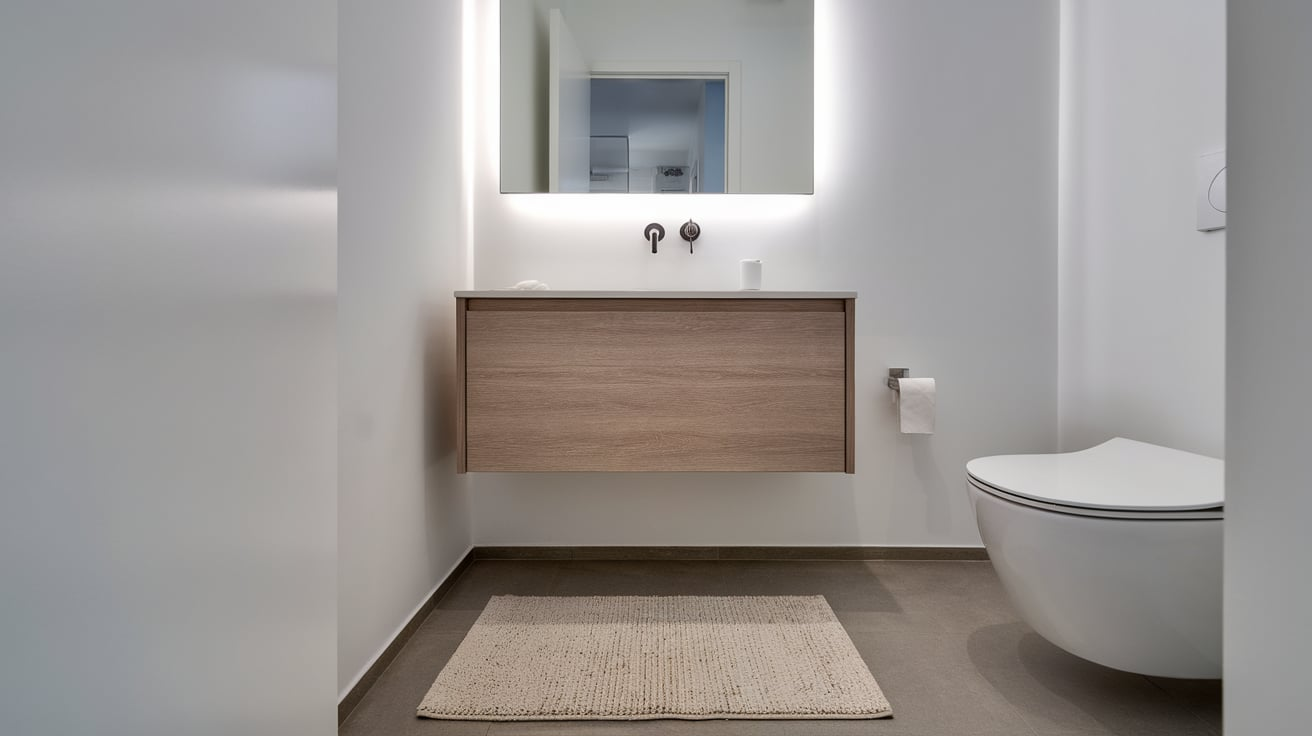
A floating vanity leaves room underneath, and placing a rug there can fill the gap while adding warmth and color. This setup brings balance to the space and can soften the sharp lines of modern fixtures.
Keep the rug to a size that fits just under the vanity without sticking out too far. A simple, low-pile rug works best so the area stays open and easy to clean.
7. Along Narrow Pathways
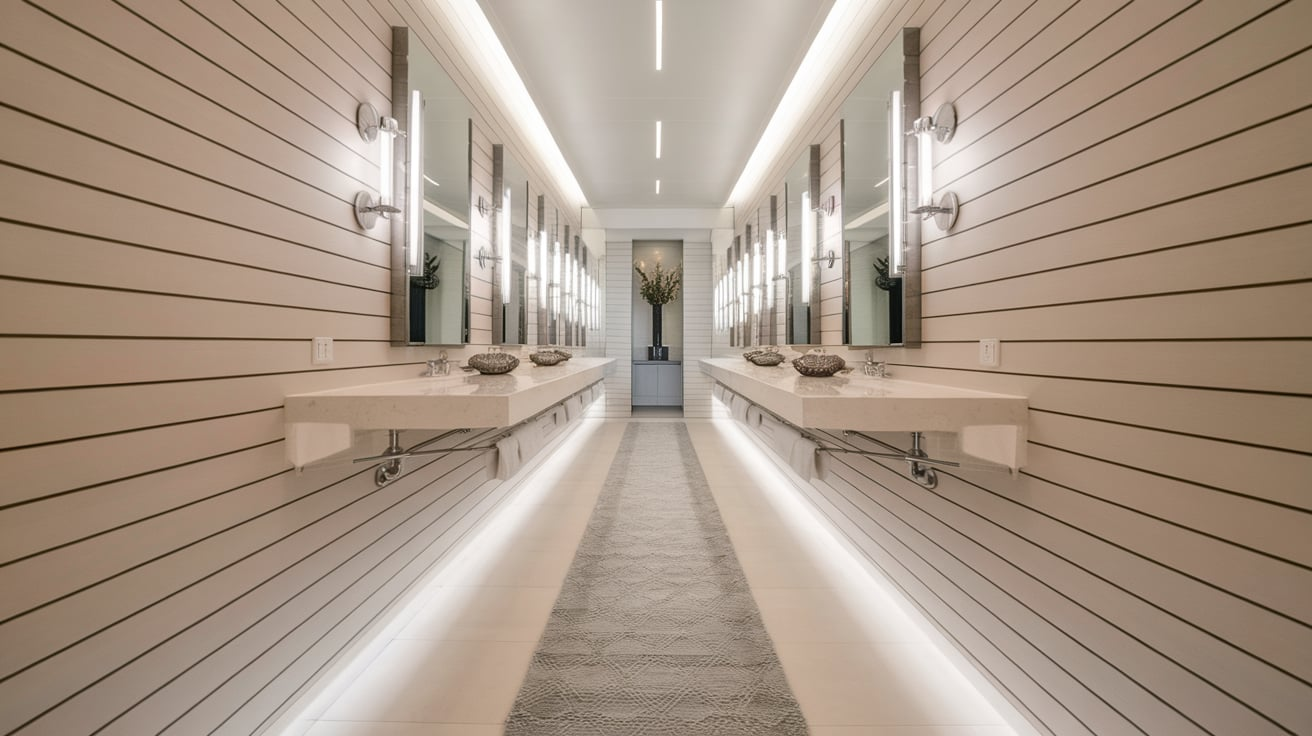
In bathrooms with long or narrow shapes, a slim runner rug helps guide the eye and movement through the space. It adds softness and draws attention to the layout without adding bulk.
Choose light colors or soft patterns to keep the space from feeling closed in. A simple design helps the room look longer and brighter.
8. Layered Rugs for Texture
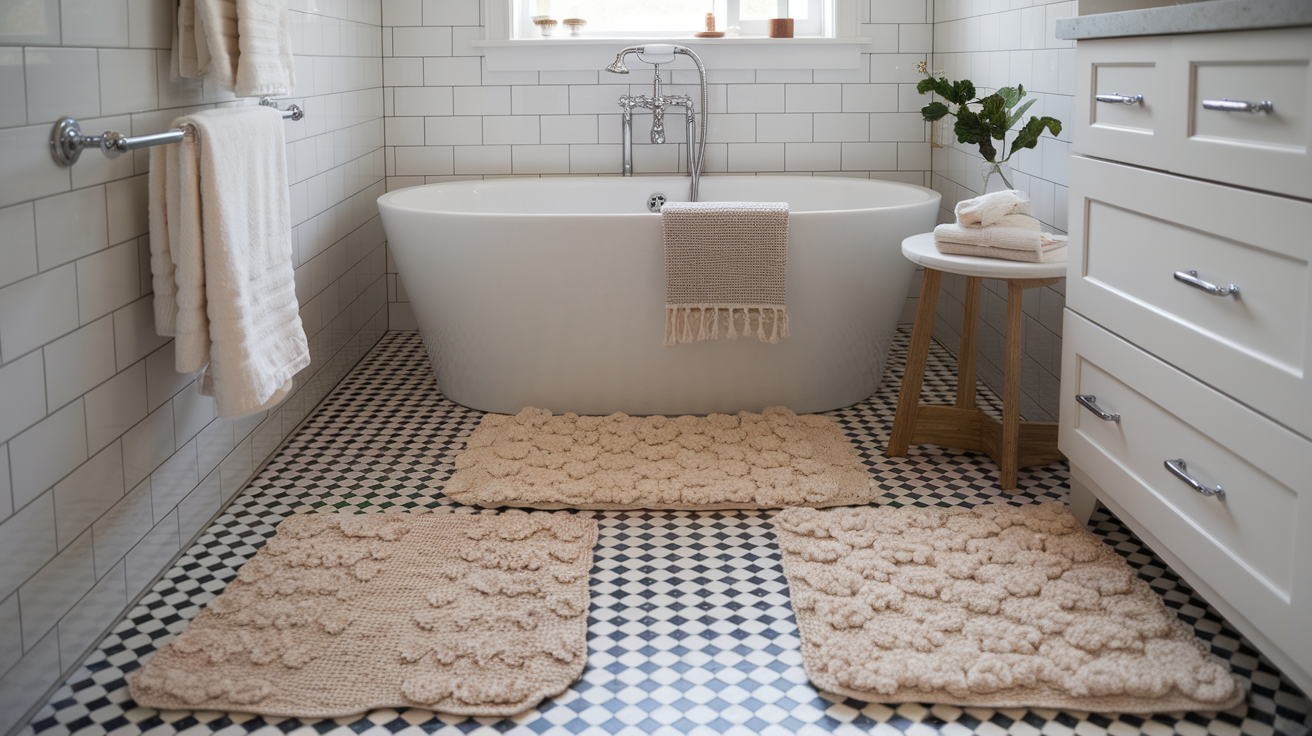
Layering rugs can bring depth and interest to even a small bathroom. Place a decorative rug on top of a larger neutral one to add pattern and softness without overwhelming the room.
Make sure both rugs lie flat and are anchored so they don’t shift. This approach works best in low-traffic corners or near the tub, where it adds style without being in the way.
9. Diagonal Placement for Visual Interest
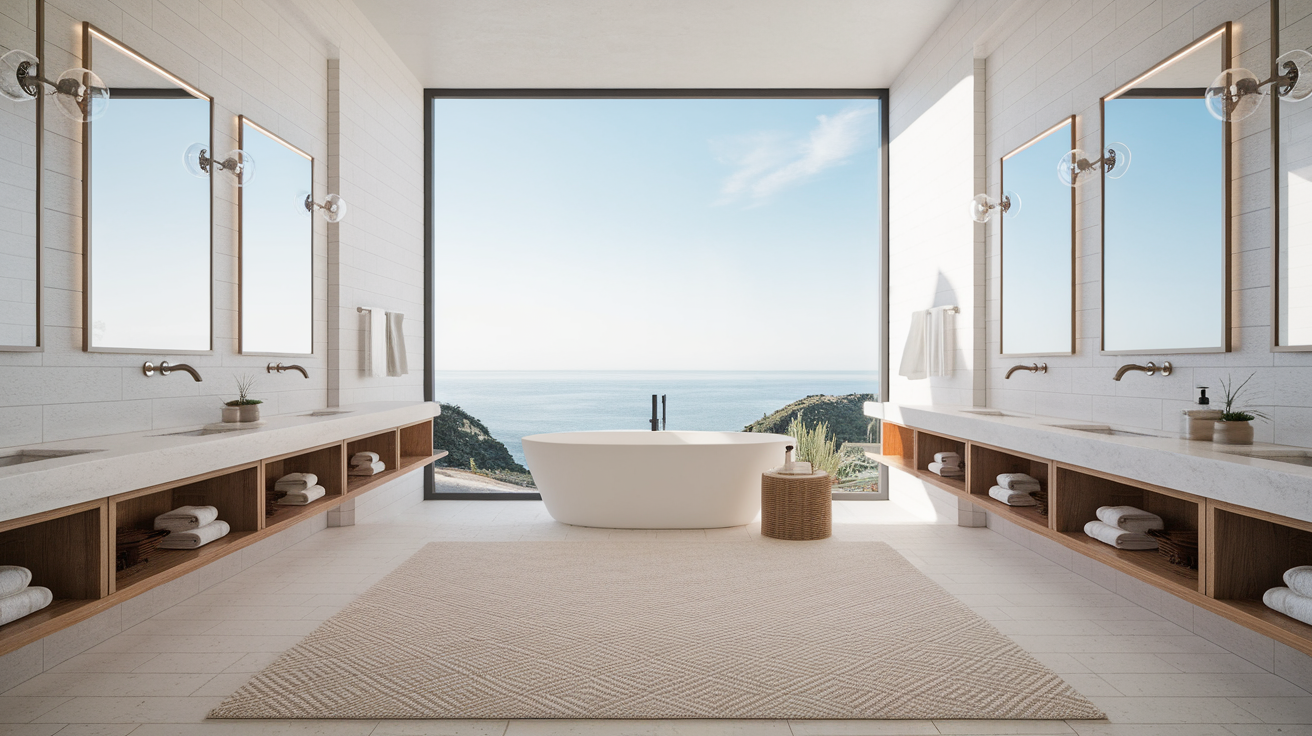
Placing a rug at an angle across a square bathroom floor can break up the straight lines and make the room feel less boxy. This trick works especially well in rooms with few design details.
A diagonal layout draws the eye and gives the illusion of more space. Use a smaller rug so it doesn’t run into walls or fixtures.
10. Under a Stool or Chair
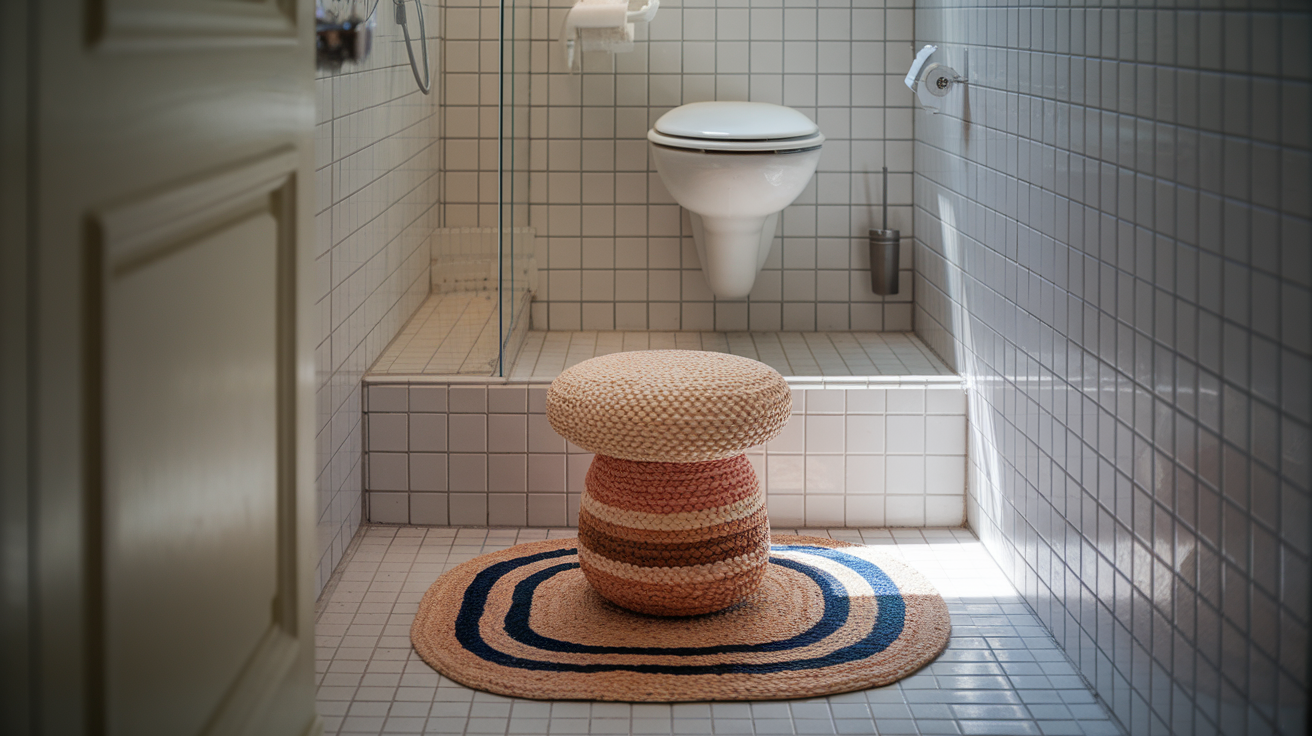
Adding a rug under a stool or chair helps anchor the furniture and gives the room a more complete look. It also makes sitting down or resting your feet more comfortable.
Pick a rug that matches the size of the furniture. Try to coordinate it with your towels or shower curtain to keep the space looking pulled together.
11. Opt for Light Colors
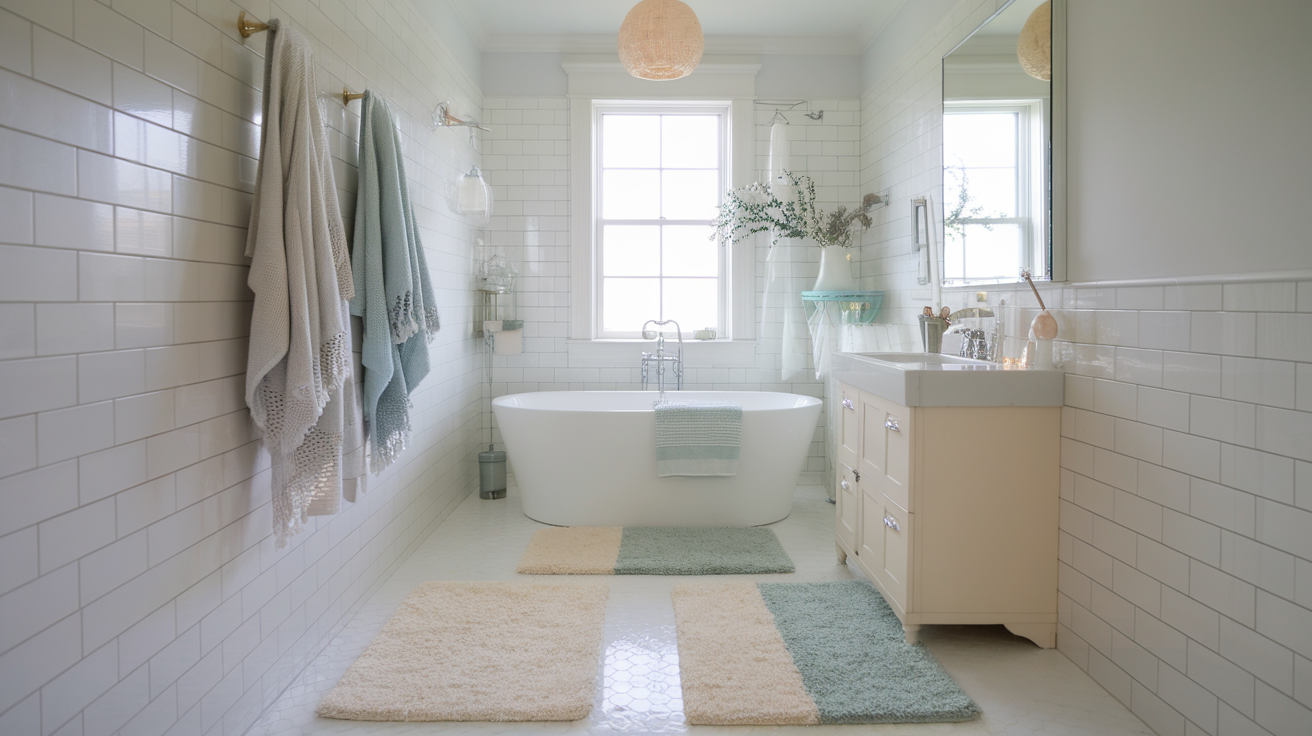
Light-colored rugs can help small bathrooms feel larger and more open. Shades like white, cream, or soft blue reflect light and make the space feel brighter.
If you’re unsure, start with a pale neutral color. These tones are easier to match with other items and can make the room feel cleaner and calmer.
12. Choose Quick-Drying Materials
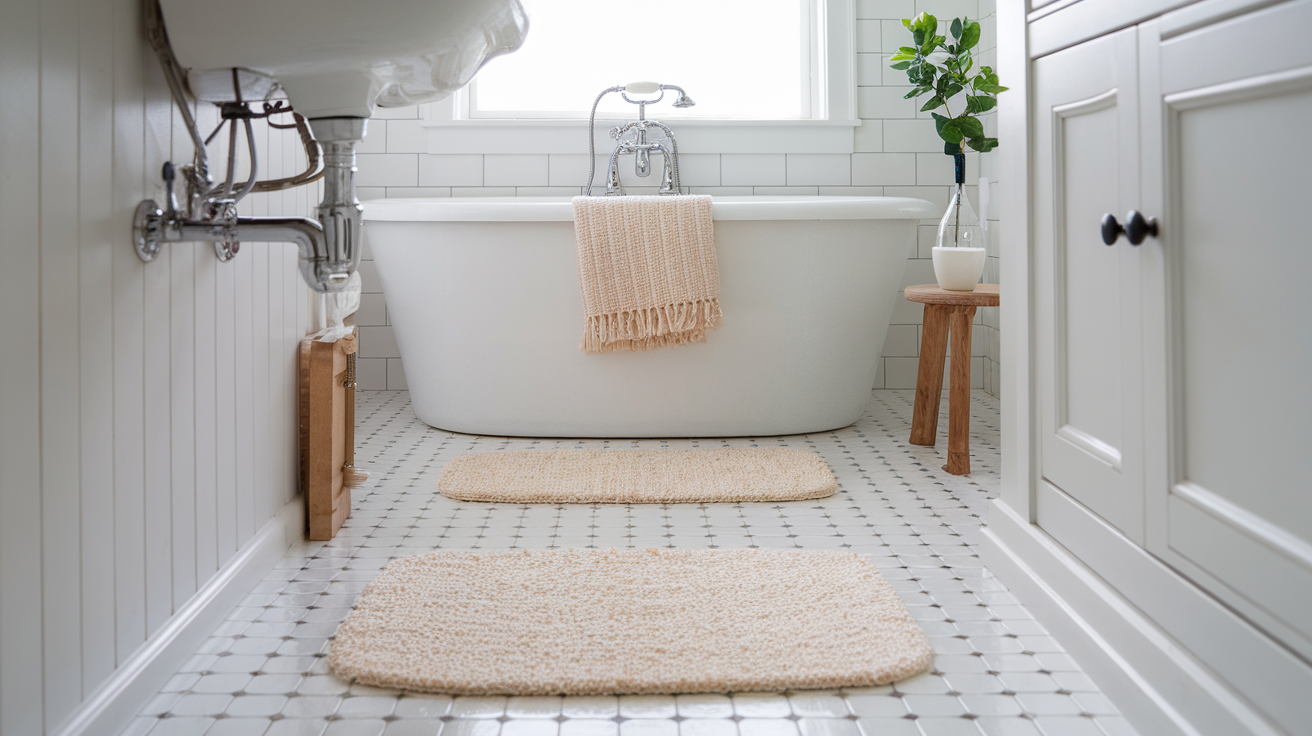
Bathrooms stay damp, so rugs that dry quickly are a smart choice. Materials like cotton or microfiber handle moisture well and can be tossed in the wash often.
Stay away from heavy or thick rugs that trap water. Quick-drying rugs help avoid mildew and make cleaning simpler.
13. Use Non-Slip Backings
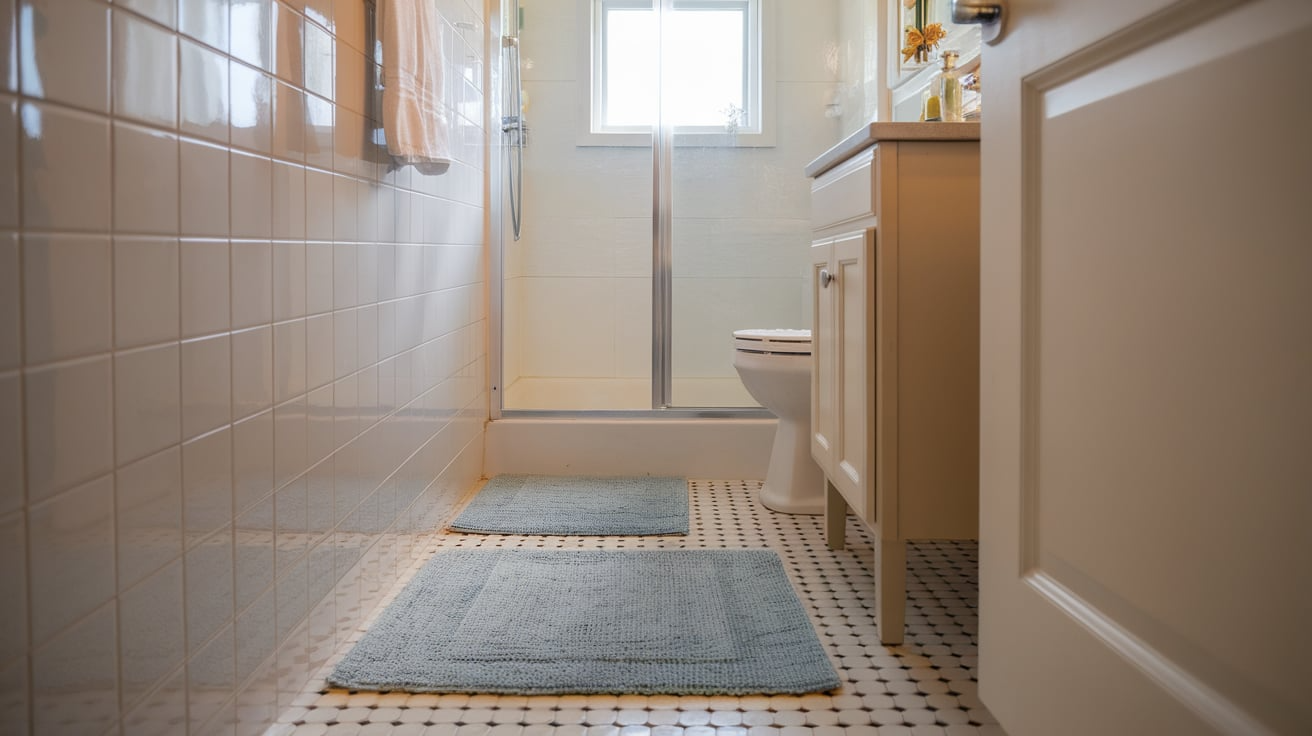
Non-slip rugs are important in any bathroom, especially small ones with wet floors. A rug that stays in place helps prevent slips and falls.
If your rug doesn’t already have a non-slip bottom, place a rubber rug pad underneath. It keeps things safer and helps the rug stay flat.
14. Match Rug Shapes to Bathroom Layout
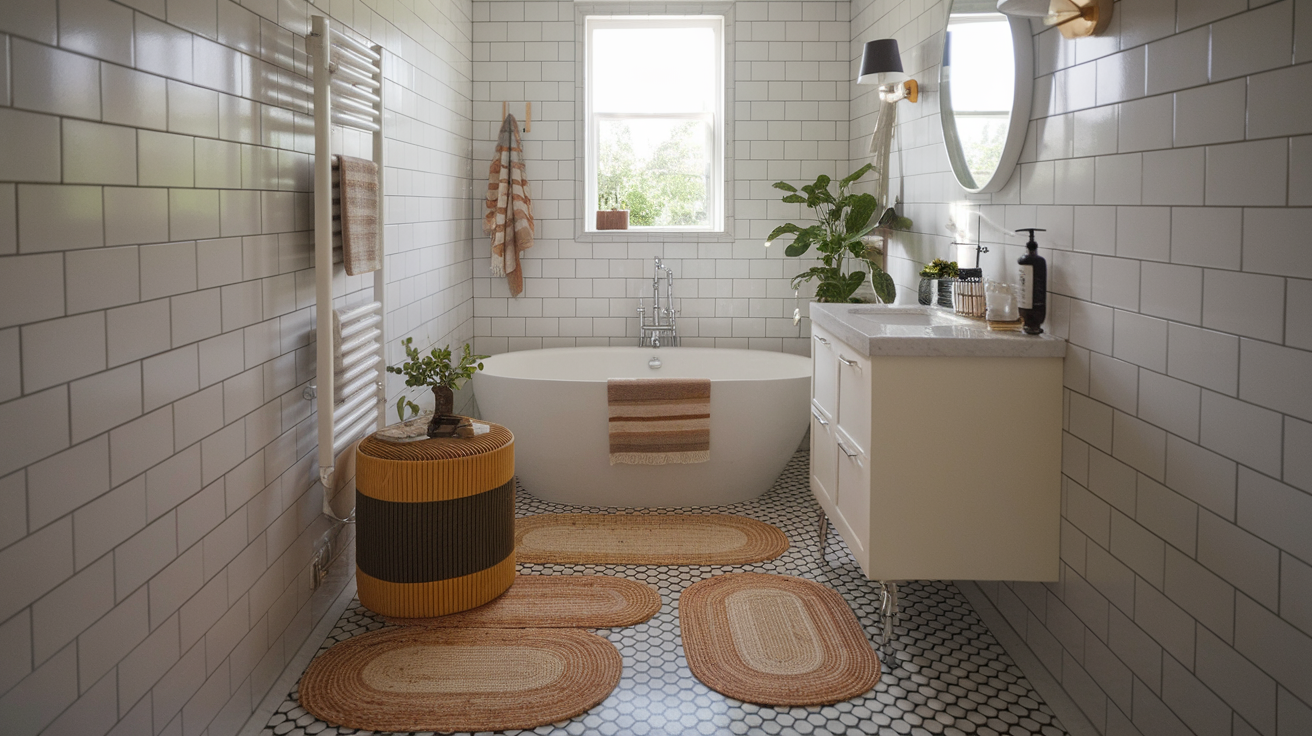
The shape of your rug should match the shape of your bathroom. Long rectangular runners are best for narrow spaces. For more square layouts, try round or square rugs.
This trick helps the room feel balanced. It also makes it easier to move around without bumping into corners or edges.
15. Coordinate with Existing Decor
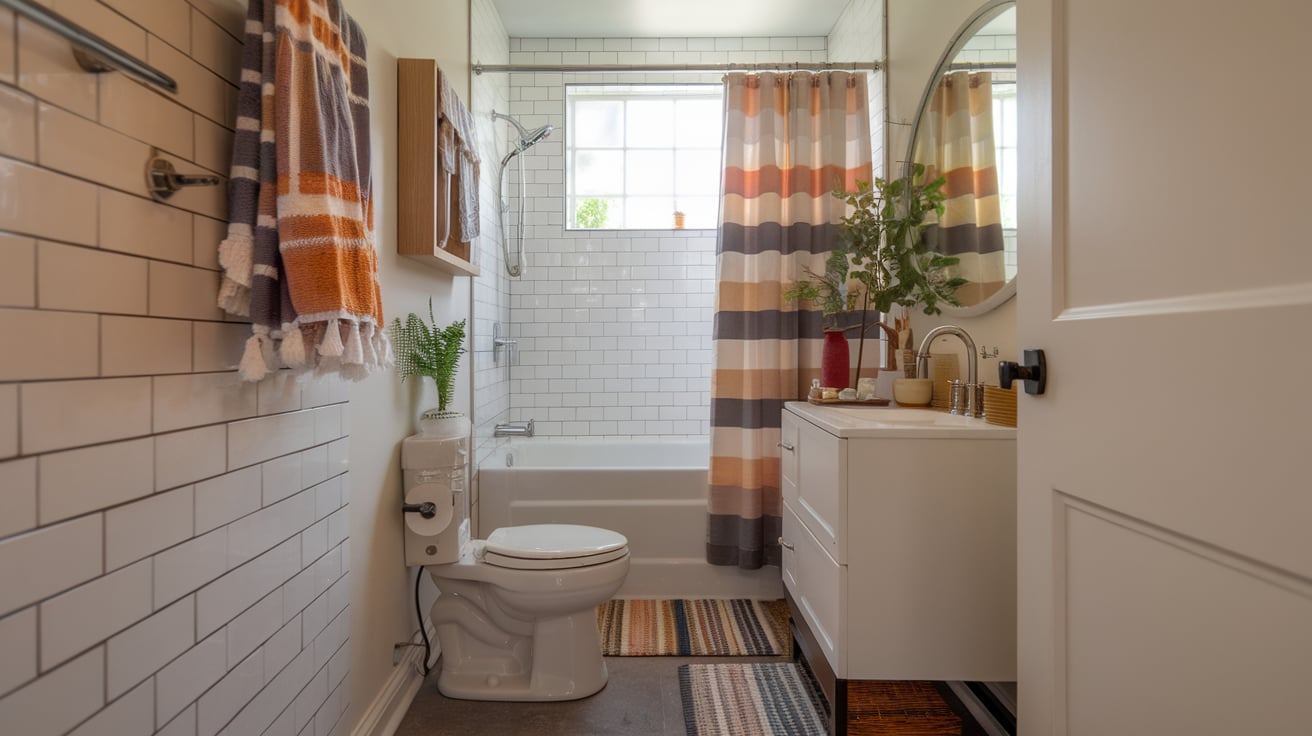
Rugs that match your bathroom’s colors and patterns help the whole space feel more put-together. Choose shades that tie in with your towels, shower curtain, or wall color.
If you like patterns, try stripes, florals, or subtle prints that repeat shapes already in the room. A coordinated rug helps your small bathroom look more planned and balanced.
16. Regular Cleaning
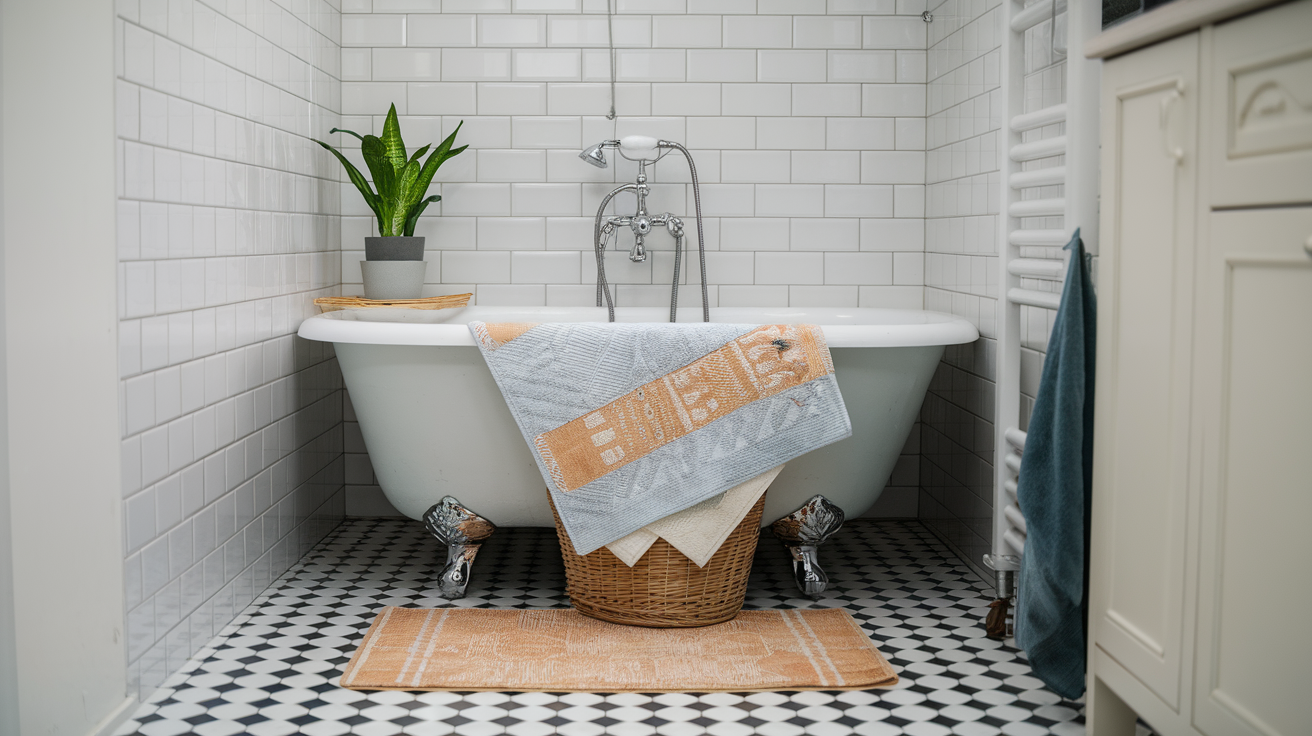
Bathroom rugs quickly collect water, dust, and hair. Washing them often keeps your space clean and reduces the risk of mildew or odor.
Always follow the rug’s care label. Some rugs are machine-washable, while others may need to be spot-cleaned or air-dried.
17. Proper Drying
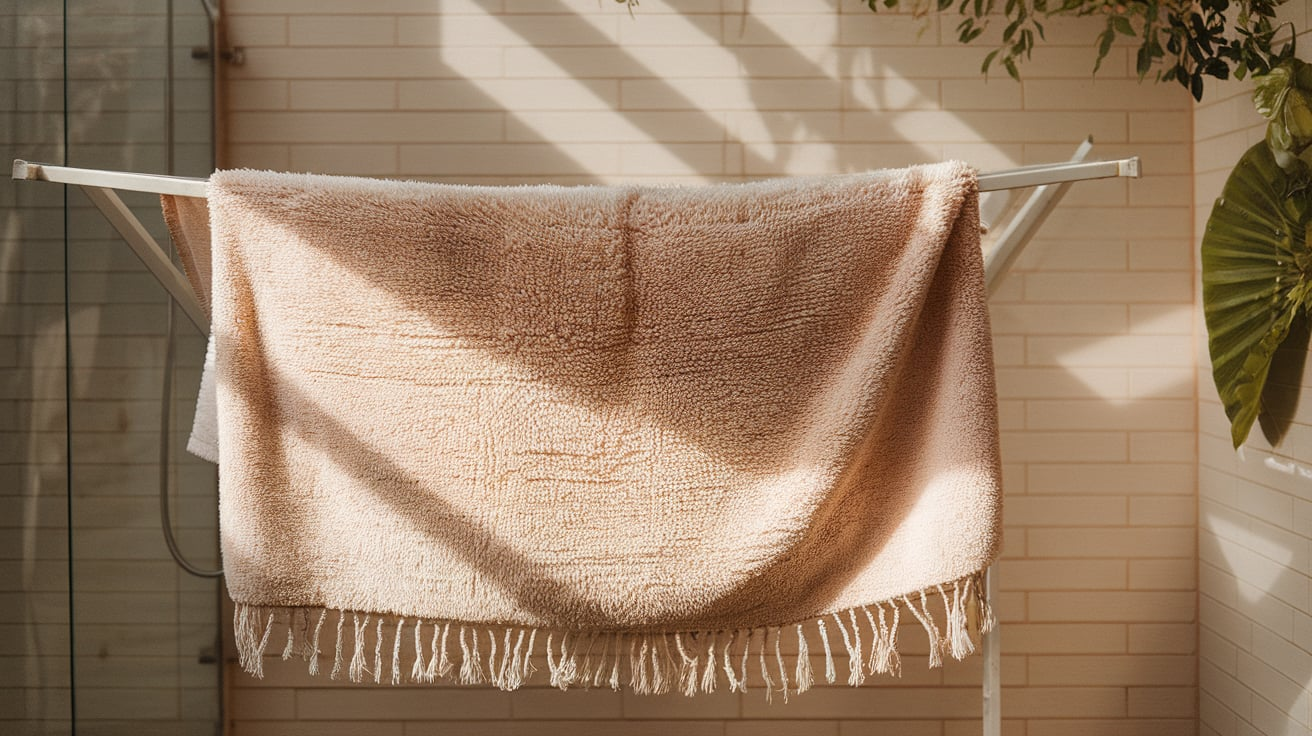
After washing, dry your rug fully before putting it back in place. Damp rugs can grow mold or mildew fast, especially in closed bathrooms.
If possible, hang rugs outside or use a drying rack indoors. Never place a wet rug directly on tile or wood floors.
18. Replace Worn-Out Rugs
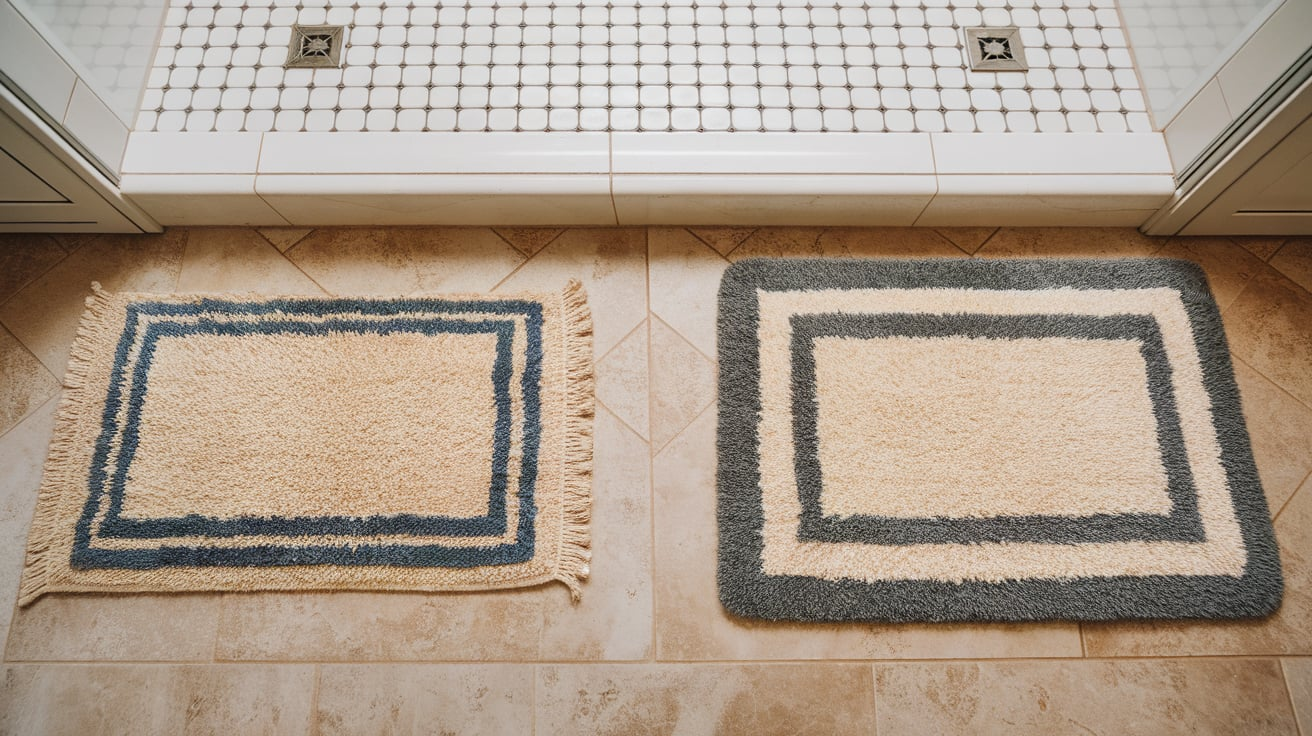
Over time, rugs start to wear out. The fibers can flatten, the backing may peel, and they might lose their grip on the floor.
Check your rugs regularly for signs of wear. Replacing them as needed keeps your bathroom both safer and nicer to look at.
19. Secure Rug Placement
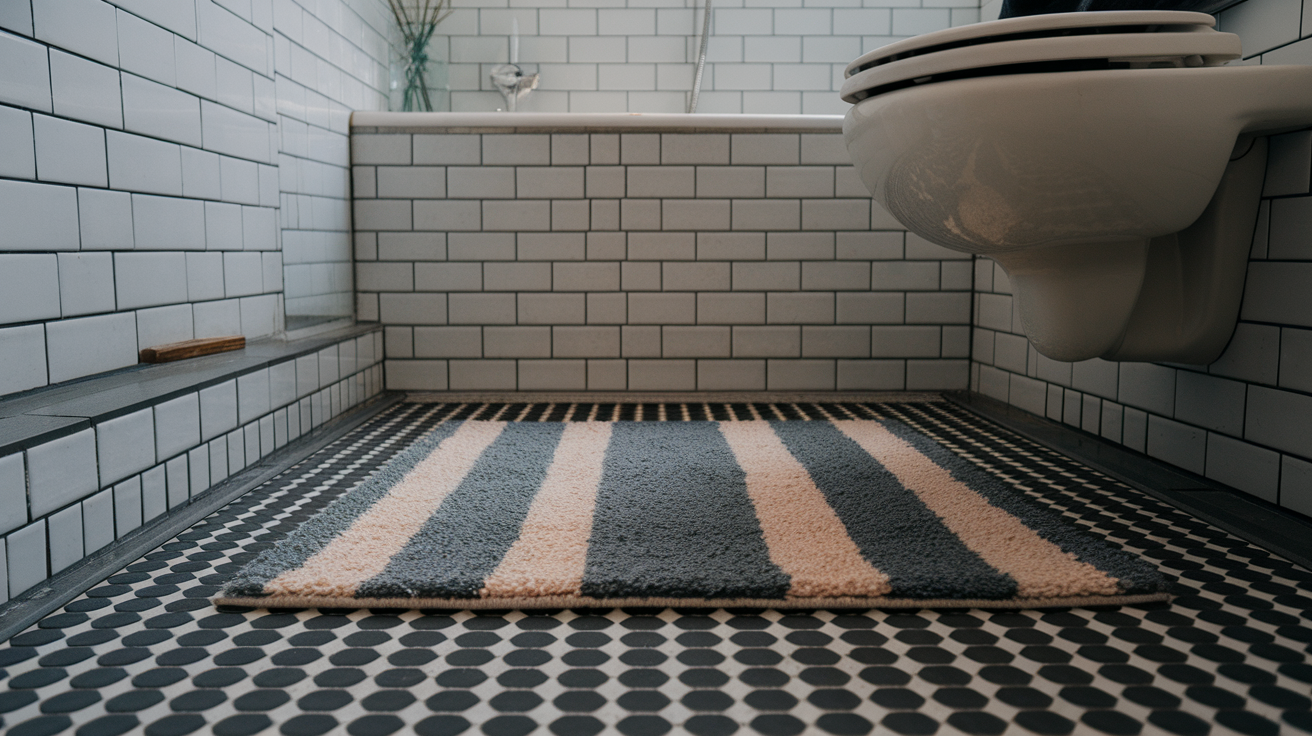
A rug that slides around is not just annoying—it’s dangerous. To avoid falls, always use a rug pad or non-slip mat underneath your rug.
You can also try adhesive strips if the rug tends to shift. Keeping it in place helps the rug last longer and stay comfortable to use.
20. Avoid Overcrowding
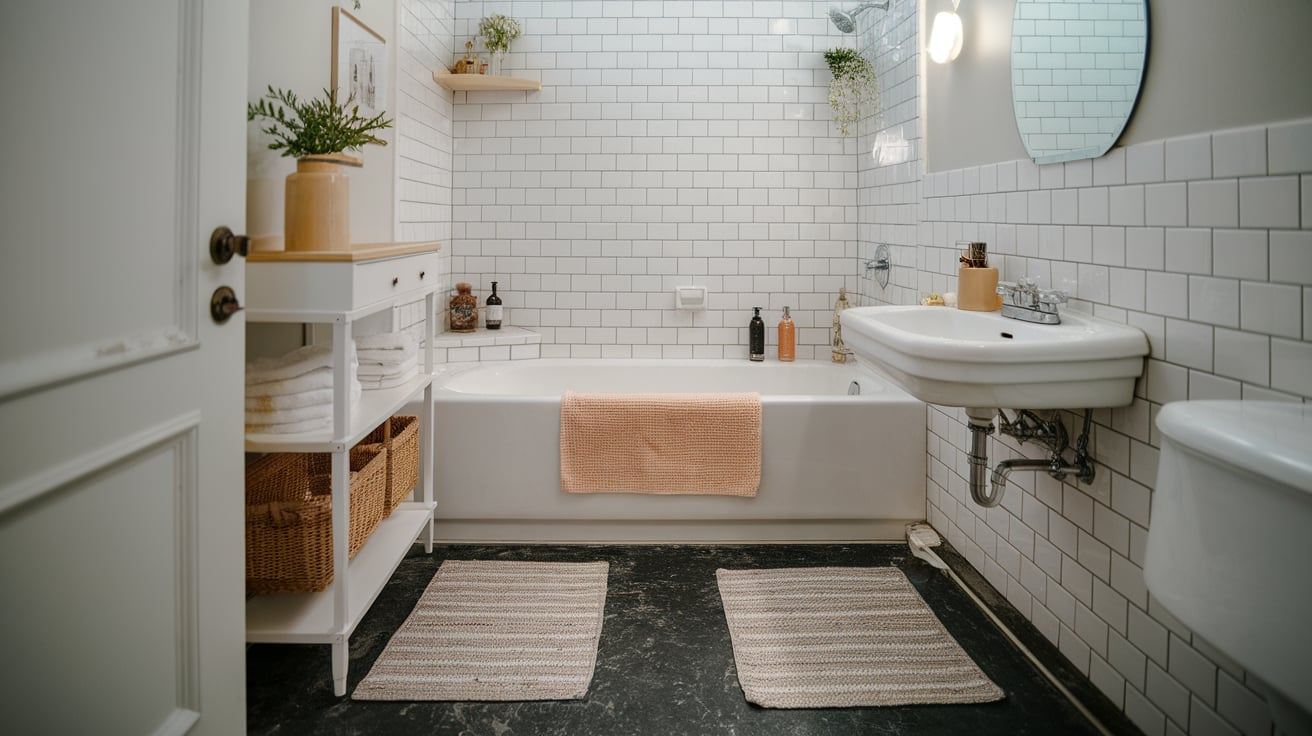
Too many rugs can make a small bathroom feel cluttered. Try to limit the number of rugs to one or two that serve a clear purpose.
Place them where they’re needed most, like near the sink or tub. Keeping the floor mostly open helps the room feel larger and cleaner.
21. Themed Rugs
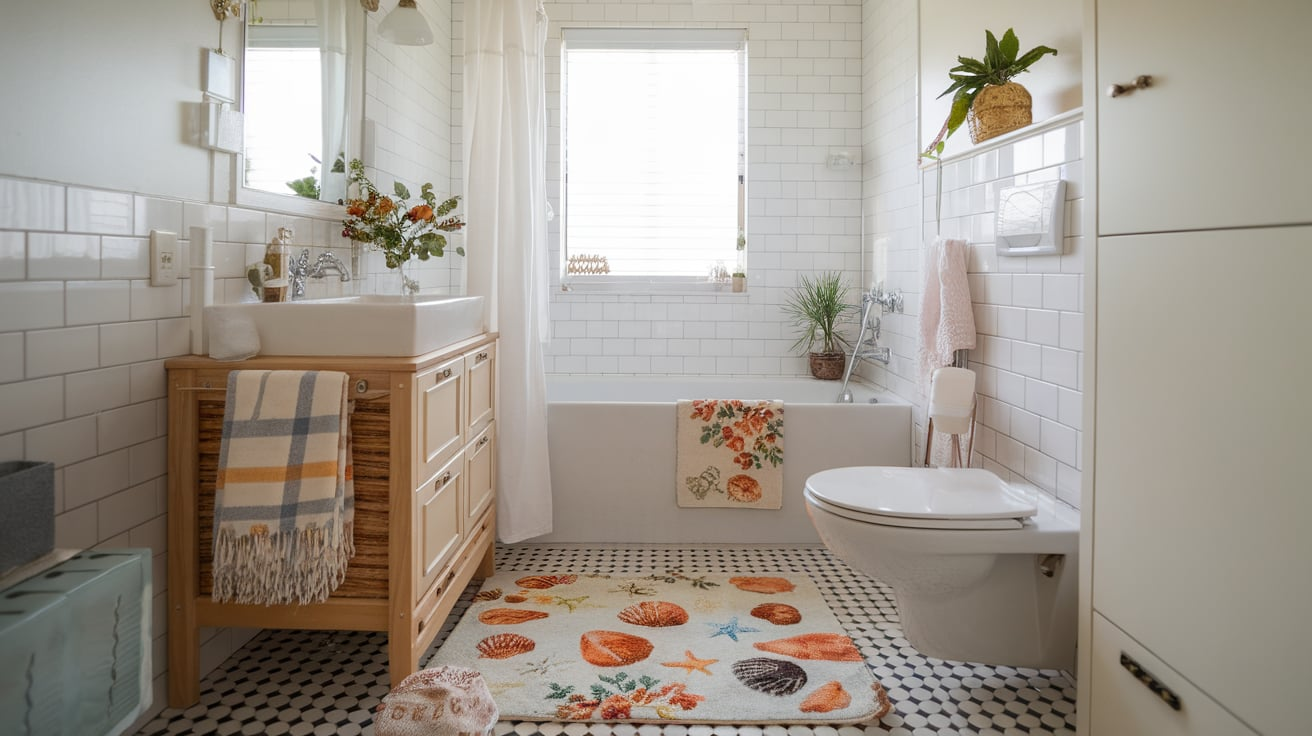
A themed rug can make your bathroom feel more personal. Look for rugs that match a color scheme, season, or even a fun motif like seashells or florals.
This is a simple way to refresh the space throughout the year. Swapping themes can keep the bathroom feeling fresh without major changes.
22. Bold Patterns
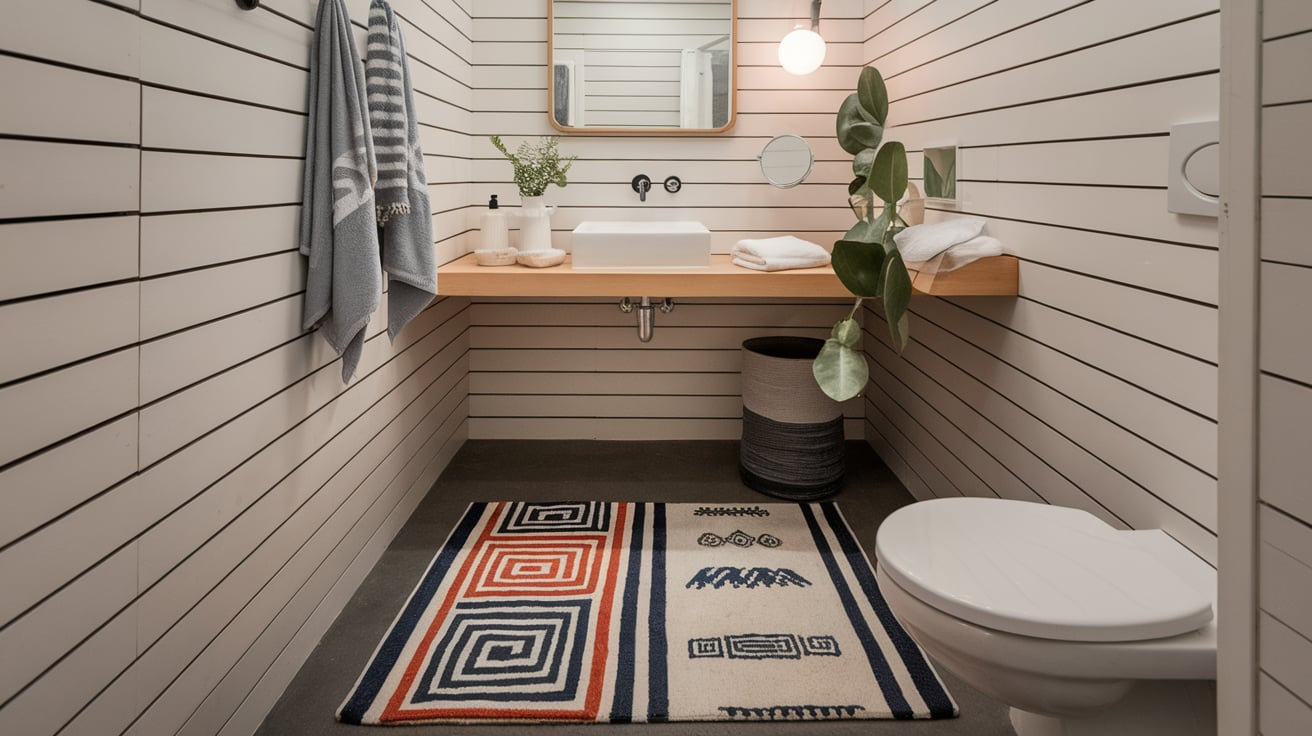
Rugs with stripes, checks, or large prints can make a strong impact in a small bathroom. They help draw attention to specific spots, like the vanity or shower.
If you use a bold rug, balance it out with plain towels or walls. That way, the space doesn’t feel too busy or cramped.
23. Textured Rugs
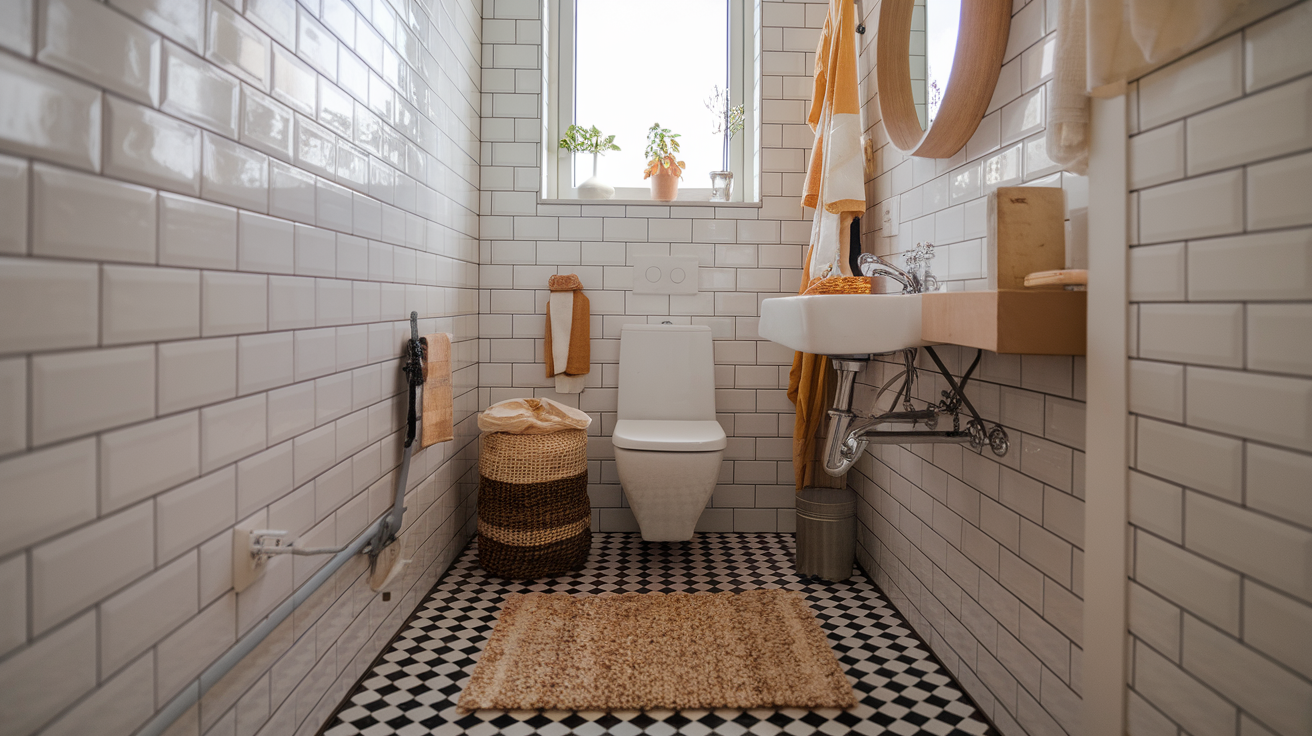
Textured rugs add a cozy, touchable layer to your bathroom floor. Materials like shag, looped cotton, or woven jute can give the room a soft and warm feel.
These textures also bring visual depth. Just make sure the rug is easy to clean and suited for damp conditions.
24. Eco-Friendly Options
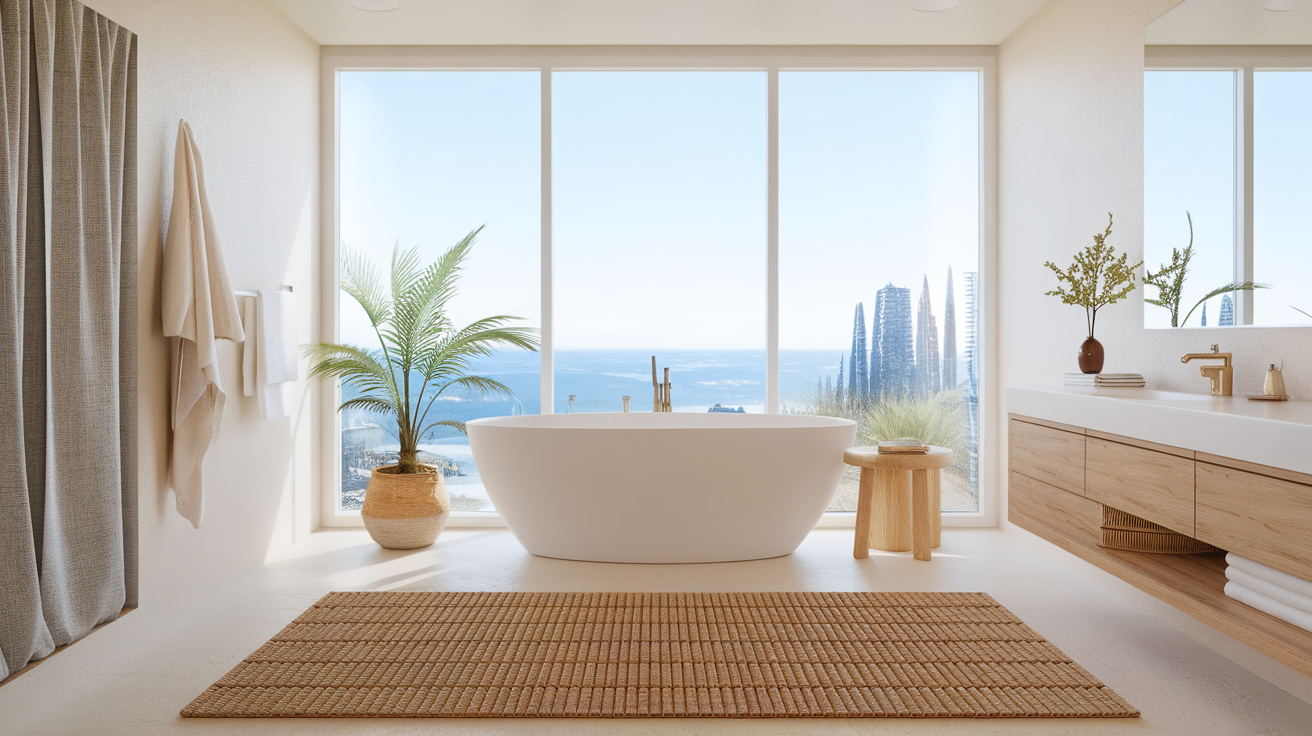
Natural rugs made from materials like bamboo or organic cotton are a great choice. They’re gentle on the environment and often feel better underfoot.
These rugs are easy to find and come in many sizes and styles. They’re a simple way to care for your space and the planet at the same time.
25. Custom-Fit Rugs
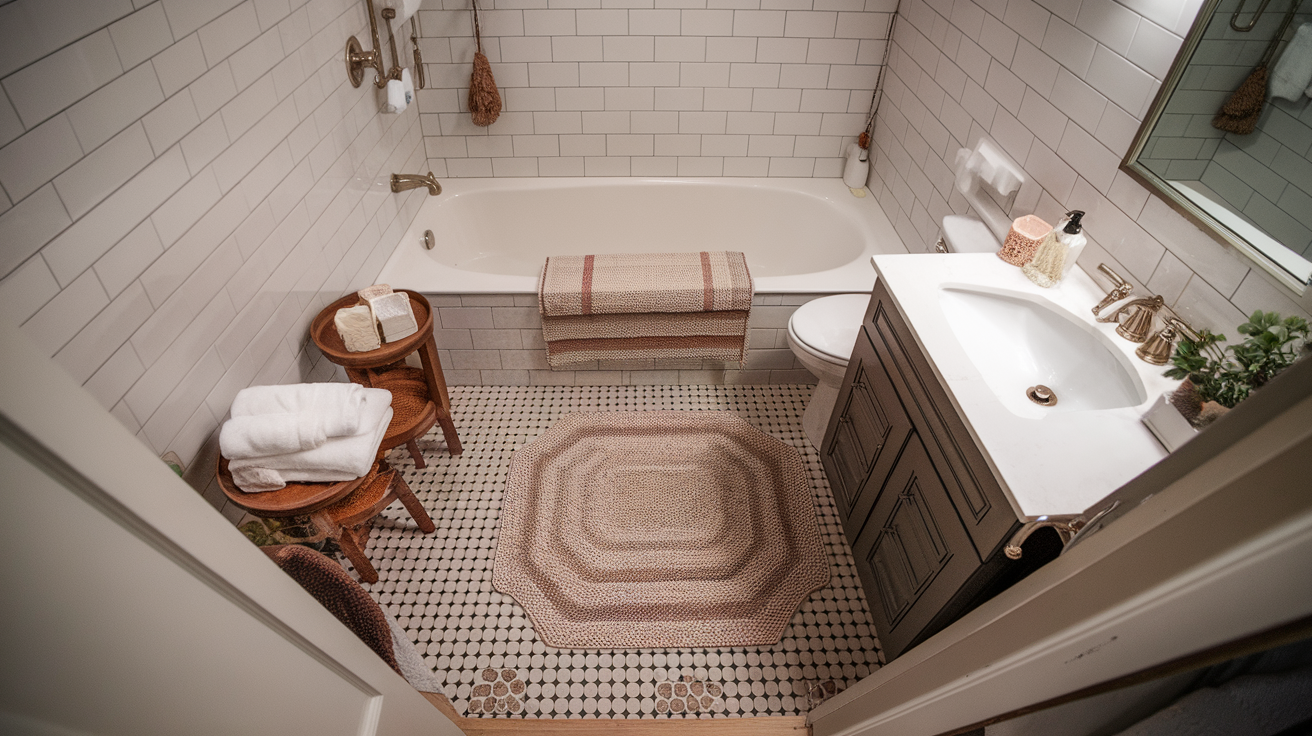
Bathrooms don’t always follow a standard shape. A custom-sized rug can help fill unusual gaps or corners while keeping everything balanced.
Having a rug that fits just right helps protect your floor and makes the room feel well-planned. It’s a good option if other rugs never seem to sit quite right.
Conclusion
Small bathrooms may be short on square footage, but they hold big design potential. With thoughtful rug placement, you can bring order, comfort, and style into a tight area without adding clutter.
The right rug can help keep the floor dry, mark out different spots, and add softness underfoot. Choosing the right spot for each rug also helps the room look more put-together and feel easier to use day to day.
Before choosing a layout, take a look at your space and think about what would help it function better. Try placing one rug at a time and see what makes the room feel more balanced and clear.
Even simple changes, like where you place a small rug, can improve the feel of a bathroom. A few inches in the right spot can turn a tight area into a more peaceful and useful space.

